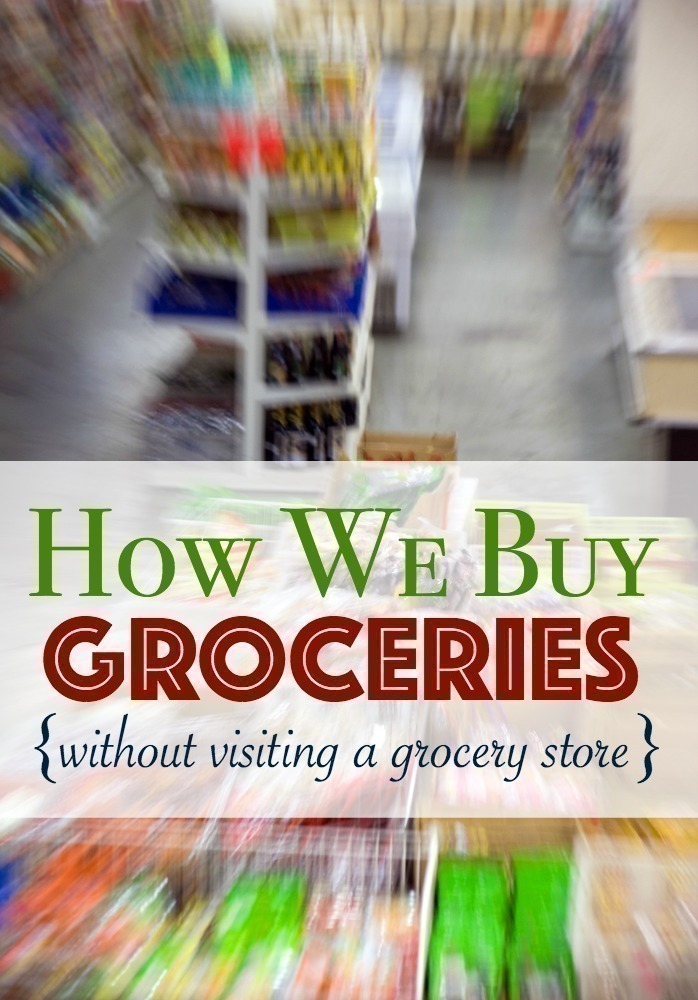
Would you be surprised if we told you that we rarely EVER go to the supermarket? It’s so very true.
Grocery Shopping was never something that I enjoyed doing. And when you have to tote along several kids and battle very skinny aisles and busy stores it’s just even more stressful. Not to mention 85% of supermarket food is processed.
We used to go – quite a bit actually. Every week, multiple times a week – sometimes multiple times a day. Did it save us money in the end? Not really – we actually didn’t realize how much we spent and the food we were buying wasn’t really even food.. Boxed items? Kids cereal? Packaged pasta? Not really want our goals are for our own health.
There is nothing pleasant about going to the supermarket — not friendly, too many people, kids fight, prices are really high (at least to me they are)… but I will tell you in all honesty, I HATE IT. And the grocery ads? I hate them to and they go right in the trash because after you stop going TO the supermarket you realize that the supermarket isn’t really necessary for most items.
It’s the truth.

We shop at Costco on a large trip once a month – it works great for our family of 6 (soon to be 7). Some of you have asked us what we buy at Costco – we recently mentioned 20 Organic Items you should probably look for at your store and we use that as a guide.
This is what goes in our cart at Costco:
- 4-6 loaves of Dave’s Killer Bread
- 1 pack of 2 Jars Costco Organic Creamy Peanut Butter
- Fresh Pineapple
- 10 lb Bag Organic Carrots
- 2 – 3 bags of Organic Bananas
- 1-2 bags of Organic Spinach
- 1-2 packs of Organic Flour Tortillas (Refrigerated)
- 1 block of Organic Cheese
- 3-4 dozen Organic Eggs
- 5-10 lb bag Organic Sweet Potatoes
- 6 pk of Organic Pasta and 4 pk Classico Organic Pasta Sauce
- 6 pk Organic Chicken Broth
- 10 lb Organic White Sugar
- Red Star Active Dry Yeast (HUGE bag is just under $5 and we do a lot of breads/rolls)
- Organic Chia Seeds & Organic Quinoa
- Horizon 1/2 Gal Organic Half & Half
- Butter – Costco brand Organic
And occasionally (very rarely!) we will pick up Organic Chicken – we don’t eat too much in the way of meat (no red meat, no pork products and chicken maybe 1-2 meals a month). We prefer to revolve our diet around the produce on sale, and it’s relatively easy to forego meat when you make your meals that are based on produce.
One thing I hear most often is that without eating meat we aren’t giving our bodies enough iron – we don’t rely on meat for iron, instead we pick up our iron from Kale, Broccoli, Lentils and Chickpeas – all of which we cook with daily. Raw Milk (NOT processed) is also helpful too because unlike processed milk, it aids in the absorption of iron.
We may make 1 additional trip back in mid-month to get another block of cheese, more bananas, and another couple pineapple but that one trip usually runs us $200. The bread goes in the freezer, and the eggs work out well for all the baking I do.. and I bake a GREAT deal.
The Carrots, and Pineapple get chopped up for lunches and some shredded for breads & muffins. The Chicken Broth works out great for soup dinners, and that huge bag of sugar usually lasts us 3-4 months, less if we are canning strawberries.
Wondering where we get our detergent? Paper towels? Both are some of the items we DO NOT buy. While others might find them a necessity, they aren’t, and they are several items of a larger list of things we just don’t purchase.
So where do we get the rest of our food?

Produce from our CSA
Every week we pick up our Family Share of produce from our CSA – the huge bag is $25.00 for the family size and that bag provides us enough to make lunchboxes and dinners for all of us for the entire week. NOTHING gets wasted.
I love having the challenge of using up all of our produce – it works out well for lunchboxes (Cauliflower, Broccoli, Carrots, Cherry Tomatoes and even sliced Green Bell Peppers & Celery)… my kids love having a variety and the little ones just love carrots & pineapple. Cut up produce and keep it at reach for them in the fridge and they are great at helping themselves.
Although a CSA can have its perks, if you don’t like to cook or try new vegetables or if you eat out a lot, then it’s probably not a wise choice for your family. Want to try a CSA? There are several in Arizona – you can read our last post for more.
Milk from the Farmer
We buy our milk directly from the Farm here in our local East Valley. There are several farms in Arizona that sell milk from the farm, but not too many that sell Raw Milk. Our dairy is in Queen Creek and we make that one trip each week (along with over MANY other families!) to pick up 3-4 gallons.
The milk is $10 per gallon so we spend $30 – $40, and we use one of those gallons to make our own Yogurt once a week – one gallon results in 5 pints of Homemade Yogurt, and 3-4 pints of Whey. The whey we keep and use for quick breads, muffins, pancakes and in place of recipes that use Buttermilk. Nothing is wasted.
The Yogurt works well in Corn Muffins, too.
Amazon & Vitacost
We have had Amazon Prime for a few years, we rely on Amazon for certain pantry staples – Bob’s Red Mill Organic Steel Cut Oats, which last quite a LONG time and are great for breakfast. toilet paper, Coconut Oil, Organic Cornmeal, and Coconut Milk. There are far too many great deals on Organic products on Amazon that are less for us in bulk, and better priced than those you find in store. These staples are not weekly items though – they will last us up to 2 months and we may spend $20 – $25 a month on them.
We pick up Organic Wheat & All Purpose Flour on Vitacost 8-12 bags at a time (which covers us a few months!), as well as Lentils and Chickpeas.
But what if you purchase meat?
Just a few weeks ago we mentioned that picking up meat from a local farmer is better for your health than the meat you find in the supermarket. Sure, the supermarket meat might be easy to obtain.. and usually always on sale, but you are sacrificing quality for cost and that can have some pretty big implications down the road.

It all boils down to one question: Do you want to know where your food comes from?
MOST meat in the United States is raised in confined animal feeding operations (CAFO’s) – it’s a confined operation, that is controlled by climate, and is the cheapest way to raise meat for profit. Food production allows CAFO’s to produce MORE for less, through low profit-margin production, processing and distribution. Our government subsidizes these operations, which often involve large feedlots of animals crammed into smaller spaces.
Grain-fed cows eat a diet in grain, corn, molasses, cottonseed and protein supplements. Remember though that unless the grain is organic, it’s likely GMO Corn and Soy Grain that they are eating (which is not really great for the consumer but cheap for the farm or CAFO).
Cows that are Grass-fed eat nothing but their mother’s milk and pasture – the American Grassfed Association certification does not allow for ANY hormones or Antibiotics to be administered (unlike CAFO’s – where they are heavily relied on).
Buying your Meat directly from a farmer is not only more satisfying, it gives you the chance to meet the person who raised the animal – it gives you the chance to ask questions on the meat you will be ingesting. Not only that, it gives YOU control of your food at a price that might just be more favorable than the supermarket.
Will this Work for Everyone?
Certainly not – and we don’t expect everyone to think that this is for them. So before you pop over on Facebook and mention that we are telling people to neglect their local businesses, we certainly aren’t doing that at all.
Instead of spending our money at the grocery store, who doesn’t have OUR best interests in mind, we are supporting local agriculture – and that, has some tremendous benefits for our local economy. We love to know where our food comes from and we would prefer to support those who have the same mindset that we do.
It WORKS for us, it may not work for you. We prefer and LOVE making our own food from scratch. We have families and obligations much like others – but food is important to us, it goes far beyond a grocery cart, weekly ad and a coupon binder.
Do we spend more?
Perception may lead people to think we spend more – after all, my neighbor thinks spending $10 on a single gallon of milk is more than ridiculous. While we might spend more on certain things, in reality.. you can spend the same $30 at the grocery store for things that are not nourishment but processed – your $30 might not go quite as far but the quality of the food is much better.



